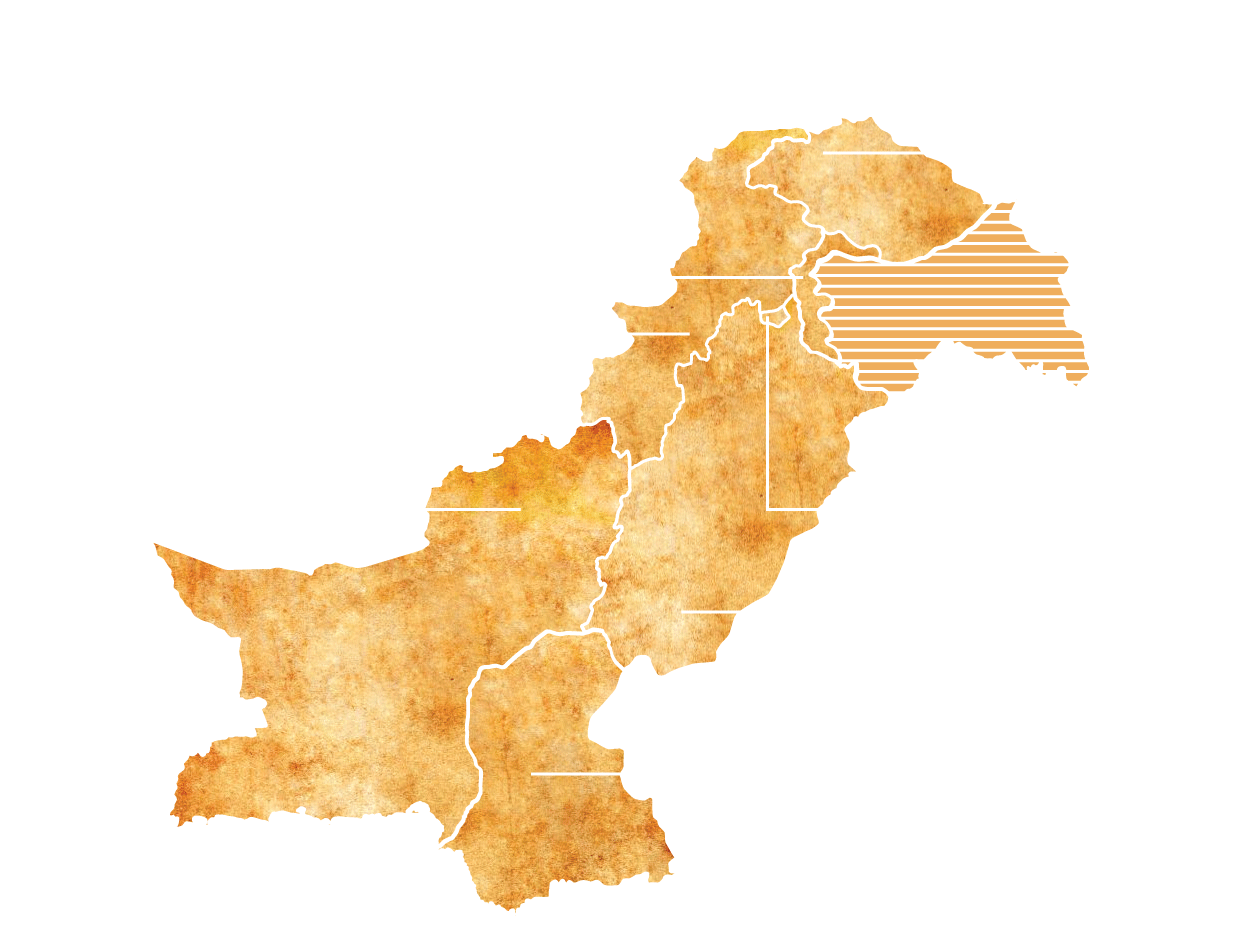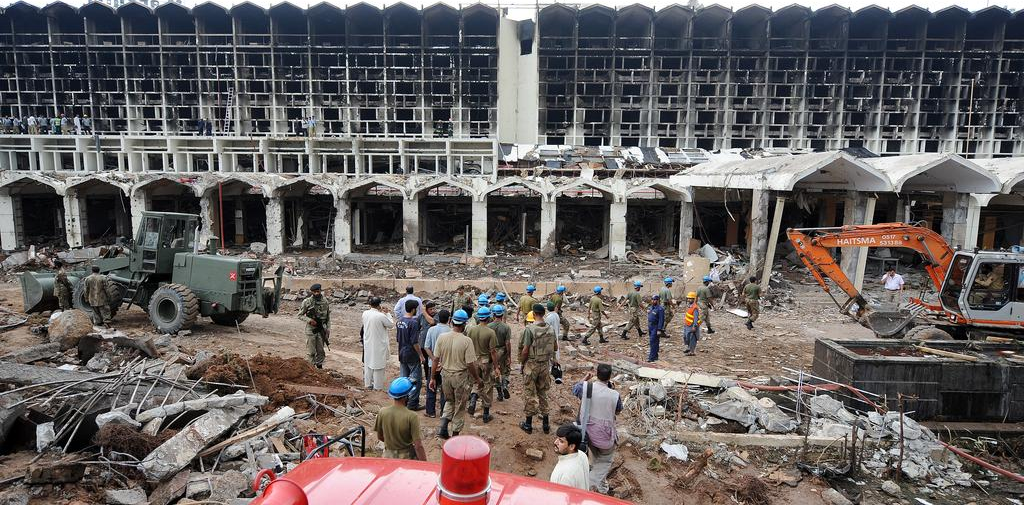Terrorism has been eradicated in Pakistan.
This is what we are made to believe. Or, this is what we’re told.
Is this true? Have we vanquished the monster? Or, has it just gone into hibernation?
Notwithstanding the recent upsurge in violence, data shows the frequency of terrorist attacks has comparatively declined. But the scourge is still very much there. So, it’s premature to claim victory.
We may have dented terrorist groups, but we haven’t eliminated them yet. We may have stemmed violence, but we are yet to tide it over. We may have smashed sleeper cells, but their sympathisers and financers still live in our midst. We may have banished the terrorist narrative, but we have failed to promote a counter narrative.

A series of military operations – especially Zarb-e-Azb and subsequent Raddul Fassad – did pay off. The command and control centre of terrorists has been annihilated, sanctuaries eliminated and launching pads dismantled. The operations led to a remarkable decline in terrorist attacks for three years, but we should not forget that terrorism ebbs and flows. Even if an operation is successful in reducing violence, there is no guarantee it will not recur.
It’s a long, deadly and painful war. It requires patience. There are no quick fixes. Scholarly studies show terrorism tends to be geographically stable which means that countries tend to experience high levels of terrorism over fairly long periods.
Even in countries where terrorist groups were comparatively small and the government had vast resources, conflicts went on for 10 to 15 years in some cases. It took the United Kingdom a quarter century to end the Irish Republican Army’s terrorist campaign. Similarly, the insurgency in Colombia has lasted for over half a century.
In 2017, terrorist violence remained heavily concentrated in certain locations with over half of all attacks taking place in four countries: Iraq (23%), Afghanistan (13%), India (9%) and Pakistan (7%), according to the latest data released by the University of Maryland’s National Consortium for the Study of Terrorism and Responses to Terrorism (START).
Overall, the numbers of terrorist attacks and fatalities worldwide declined in 2017 for the third consecutive year, according to the Global Terrorism Database (GTD) published yearly by the University of Maryland shows. There were 10,900 terrorist attacks the world over killing in excess of 26,400 people, including 8,075 perpetrators and 18,488 victims.
Globally, Pakistan has consistently been among the top 10 countries worst hit by terrorism. The first recorded attack in the country took place in 1970, according to the GTD. Since then there have been hundreds of attacks, spiking significantly after 2001, resulting in thousands of casualties. This wave of wanton violence has marred the psyche of the nation and left scars that would take years, if not decades, to heal.
Recently, The Express Tribune spoke to select authorities on terrorism to understand the phenomenon. Most agreed on Pakistan suffering from a terror spill over courtesy its neighbourhood.
Boaz Ganor: “Perhaps there has been a ‘perfect storm’ of conditions that came together to create this problem [of terrorism], relating to conditions in neighbouring states and in Pakistan itself. I don’t think that any one leader or policy is at fault or to blame. Nothing is ever that simple.”
Brian Michael Jenkins: “Pakistan’s problems with terrorism have deep roots and predate 2001. They reflect developments in both, Pakistan and the region, especially conflicts in Afghanistan and India.”

Martha Crenshaw: “Pakistan has not dealt effectively (militarily, politically, or legally) with domestic extremists and is also afflicted by spill over from events in Afghanistan. Attempts to manipulate violent groups to use them against India have contributed to loss of control and credibility.”
Brigitte L Nacos: “…there are a multitude of reason (of terrorism) here (in Pakistan): The spread of the Wahabi Islam and the establishment of Saudi-financed seminaries, tribal tradition and last but not least the resentment of colonialism and more recently of Western-dominated globalisation.”
The American Central Investigation Agency (CIA) has been carrying out a not-so-covert campaign in Pakistan’s tribal regions to take out “high-value target (HVTs)” or key leaders of the Taliban, al Qaeda and allied groups. The experts, however, posit this strategy of cutting the head of a hydra-headed monster, termed decapitation in academic circles, doesn’t help eradicate terrorism in the long run.
Boaz Ganor: “It [decapitation] cannot be the sole strategy. It must be one component of a more comprehensive approach aimed at addressing the issue, perhaps including educational reform, economic, political, or religious approaches. These types of approaches are being utilised in other countries, with some degree of success.”
Brian Michael Jenkins: “Removing leaders of a terrorist group through apprehension or military operations reduces their effectiveness. It is not that terrorist leaders cannot be replaced. In a large organisation, they can be. However, each successful action not only removes one leader, but disrupts command and control, at least, temporarily. Research shows that over the long run, so-called decapitation operations have shortened the lifes pans of terrorist organisations. At the same time, decapitation is not a strategy and cannot singularly end terrorist campaigns.”
Martha Crenshaw: “It is not clear if decapitation strikes (targeted killings) prove effective when it comes to destroying insurgent or terrorist organisations. Academics disagree. However, such strikes may disrupt violence.”
Brigitte L Nacos: “Decapitation works sometimes but not always. After the Peruvian Shining Path leader Abimael Guzman was arrested the organisation broke apart; after the founders of the German Red Army Faction were nabbed, it was succeeded by three feeble groups. But even if you do not see significant differences, continued neutralisation of leadership should eventually prove efficacious only to bring a group to the table as it happened with ETA in Spain.”

Until now, Pakistan has chiefly relied on use of force to defeat terrorists. The much-trumpeted National Action Plan that envisaged political, educational, judicial and administrative reforms is gathering dust. Can the use of military force alone rid Pakistan of terrorism? Most are sceptical.
Boaz Ganor: “The military in Pakistan has traditionally been a respected institution, often trusted by the population. It also very much has the capacity to undertake complex operations and activities. But it is also true that a military approach is not always the best way to resolve a complex problem. Perhaps the key is to utilise some of the best practices of the military in terms of planning, logistics, etc but to then act in a new way.”
Brian Michael Jenkins: “Pakistan faces more than terrorist campaigns. In some areas, these have ascended to insurgencies involving much larger and more complex organisations. Even though they use terrorist tactics, they cannot be compared with small terrorist groups active across Europe in the 1970s and 1980s. They field much larger forces. In dealing with these groups, military force may be required. Military force alone, however, is never adequate. These groups must be deprived of popular support and sources of financing.”
Martha Crenshaw: “What seems to be needed is an efficient and legitimate legal system whereby terrorists are apprehended, arrested, tried, and imprisoned, if convicted. This depends more on police and judiciary than the military.”
Brigitte L Nacos: “In most cases, military force alone will not defeat terrorists. Sri Lanka is one example where this happened. The Sri Lankan military completely wiped out the Tamil Tigers. It seems more promising to combine hard and soft power.”
According to a RAND study, in 40% of cases, worldwide terrorism has been tackled with the help of dialogue. In Pakistan too, some political and politico-religious groups advocate dialogue, at least the reconcilable groups, to address the issue. Those reached believe the approach only works in cases where demands of terrorists groups are limited.
Boaz Ganor: “…In many … contexts, like Africa or the Middle East, dialogue has often been used as ‘war by other means,’ as a tool to bide time or achieve other ends. One should be aware that the decision to engage in dialogue is not a guarantee of success, either. Some groups even quietly encourage terrorism through proxy groups to exert leverage in dialogue and political negotiations.”
Brian Michael Jenkins: “Dialogue may end some terrorist campaigns, but the RAND study has to be read carefully. The 40% includes groups that carried out some terrorist actions and then disappeared. Presumably, they gave up terrorism because they were informally co-opted into the political system, but the presumption may not always be true. Negotiated settlements with terrorists have proved difficult to achieve. This is especially true where terrorist groups are not seeking participation in the political system or making political demands that can be addressed. Some of Pakistan’s groups claim to be instructed by God to wreck the state and foist their interpretation of faith on the rest. There is very little to negotiate there.”
Martha Crenshaw: “The feasibility of dialogue depends on the identity of the opposition group as well as government willingness and public acceptance.”
Brigitte L Nacos: “Typically, when it comes to domestic terrorism, negotiations are an option as the case of Northern Ireland and more recently ETA in Spain show. Whether this is an option in Pakistan depends on the grievances and the objectives of the group(s) involved. If those causes/goals are more in the local/domestic sphere, talks make sense—if groups have bought into the transnational playbook not so much. If one assumes that Pakistani groups are more along the lines of the Taliban, I would think negotiations could lead to solutions.”
After a series of military operations, the Pakistani military also launched a program to de-radicalise potential young recruits brainwashed by terrorist groups. Does this approach work? Not always, the experts opine.
Boaz Ganor: “…It [deradicalisation] needs to be viewed in a more holistic way, or be augmented by new insights from medical science. For example, in Nigeria, the government takes a public health approach, using centres that address post-traumatic stress in concert with de-radicalisation strategies.”
Brian Michael Jenkins: “De-radicalisation is another tool. It has utility. It is not the answer. Vocational training may provide alternative means of income to former terrorist fighters, but does not address belief systems. The key question is, ‘Are these individuals in these groups simply because they don’t have jobs or because they have become true believers?’ The latter are more difficult to deal with.”
Martha Crenshaw: “De-radicalisation programs are problematic; often they are not transparent and there is no assessment of results.”
Brigitte L Nacos: “De-radicalisation does not work quickly. It is a long process and I think it has the best prospect if driven by people de-radicalised themselves.”
The media, or mass media to be precise, has a key role to play in defeating the terrorist narrative. This, in Pakistan’s case, it has not. The media and terrorism may share a symbiotic relationship. But in democratic societies, free speech or freedom of expression cannot be restricted. How can Pakistani media then de-oxygenate terrorist groups?
Boaz Ganor: “Terrorist groups often use over-simplistic explanations and understandings to win support. Media and critical voices can help debunk rhetoric by adding nuance and complexity to public discourse.”
Martha Crenshaw: “Media coverage of terrorism can magnify the message but democracies do not want to censor the press.”
Brigitte L Nacos: “There is a close link between media and terrorism. While I have high regard for freedom of speech, I think one needs anti-incitement laws criminalising pertinent communications whether in print, broadcast, or social media.”
Illustrations: Saadat Ali
Data: Global Terrorism Database
Photos: ISPR, AFP and Reuters
